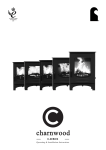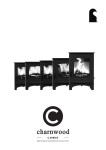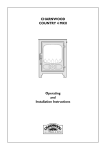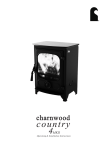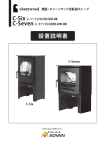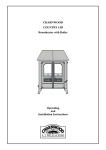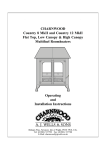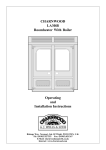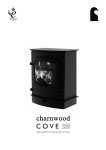Download Charnwood C4 Operating instructions
Transcript
®
charnwood
Operating & Installation Instructions
CONTENTS
O P E R AT I N G I N S T R U C T I O N S
Fuel
4
Fitting The Riddling Grate
4
Lighting
5
Controlling The Fire
5
Refuelling
5
Ash Clearance
5
Reduced Burning
6
Cleaning and Maintenance
6
Throat Plate & Flueway Clearing
6
Chimney Sweeping
6
Servicing
6
Trouble Shooting
7
CO Alarm
7
If you need further help
7
INSTALLATION INSTRUCTIONS
Health & Safety Precautions
9
CO Alarms
9
Specification
9
Chimney
9
Hearth & Fire Surround
9
Connection to Flues
10
Soot Doors
11
Pre Lighting Check
11
Commissioning
11
Clean Air Act Information
11
Dimensions
12
Parts Lists
13
Certification
14
Ref. C-FOUR v1 09.11
OPERATING INSTRUCTIONS
®
Tools required for fitting the riddling grate:
Before lighting the stove check with the installer that the work and
checks described in the Installation Instructions have been carried out
10mm Spanner
Pozidrive screwdriver
correctly and that the chimney has been swept, is sound and free
from any obstructions. The stove is not suitable for use in a shared
Before fitting the riddling grate (Fig. 1) remove the fuel retainer and
flue system.
the wood ash retainer. The wood ash retainer is not required when
the riddling grate is fitted.
Remember that the stove will be hot and that it is made from hard
materials – ensure that you have good balance before operating the
Undo the nut on the riddling blanking hole using a 10mm spanner.
fire.
Remove the cover and spacing washer (ensure you keep these in a
Do not use an aerosol spray on or near the stove when it is alight.
safe place as you will need to replace them if the riddling grate is
There is a risk of explosion or flash ignition of the spray.
removed).
When using the stove in situations where children, aged and/or
Feed the riddler rod through the hole on the right hand side of the
infirm persons are present a fireguard must be used to prevent
stove, and slide one washer onto the rod. (If there is not sufficient
accidental contact with the stove. The fireguard should be
room to the right of the stove to do this then remove the riddler
manufactured in accordance with BS 8423:2002.
knob, fit one washer over the rod and then slide the rod through the
hole from the inside of the stove.)
The stove is suitable for intermittent operation.
Feed the rod through the two side fireplates and slide the other
FUEL
washer on to the rod so that the washers end up outside the two side
This stove has been designated to burn wood. Only dry, well
fireplates. With the side fireplates pushed together fit the retaining
seasoned wood should be burnt on this appliance as burning wet
clips so that the washers come inside the clips.
unseasoned wood will give rise to heavy tar deposits in the stove, on
Slide the side fireplates apart so that they rest against the sides of the
the glass and within the chimney. For the same reason hard woods
firebox. Slot in the front and rear support plates.
(such as Ash, Beech and Oak) are better than soft woods (such as
Fit the grate plates into position through the front and rear grate
Pine and Spruce). Burning wet unseasoned wood will also result in
support plates, making sure they locate correctly onto the riddler
considerably reduced outputs.
rod. Fit the fuel retainer. Slide the ashpan under the grate.
The wood should be cut and split and then left to season in a well
Fig.1. Optional Grate Kit
ventilated dry place for at least one year but preferably two years
before use. Approximate suitable log sizes are 255mm (10in) long
Grate Plates
and 75mm (3in) diameter.
PETROLEUM COKE IS NOT SUITABLE FOR USE ON
Rear Grate
Support
THIS APPLIANCE. ITS USE WILL INVALIDATE THE
GUARANTEE.
Riddler
Rod
This stove is not designed to burn household waste.
For advice on other fuels please contact Charnwood.
Front Grate
Support
This appliance has been approved by HETAS as an intermittent
RH Side Grate
Support
operating appliance for burning dry seasoned wood logs only. HETAS
approval does not cover the use of other fuels either alone or mixed
LH Side Grate
Support
with wood logs nor does it cover the instructions for use of other
fuels.
FITTING THE RIDDLING GRATE
Ashpan
4
OPERATING INSTRUCTIONS
®
Open the air control fully (boost position) when lighting or when
LIGHTING
rapid burning is required. It should not be left fully open for long
On initial lighting, the stove may smoke and give off an odour as the
periods as this can cause over-firing or excessive smoke production.
silicon paint with which the firebox is painted reacts to the heat. This
For high output move the air control to the ‘click position’ or for low
is normal and will cease after a short time, but meanwhile the room
burning to the fully closed position.
should be kept well ventilated.
When the fire is burning normally the air control gives enough
At first only light a small fire and burn it slowly for two hours to allow
airwash to keep the glass clean. However, it will not always be
any residual moisture in the chimney to evaporate.
possible to keep the glass clean with the air control fully closed. For
Light the stove using dry kindling wood and paper or fire lighters. Put
correct firing we recommend the use of a stove pipe thermometer
the paper, or fire lighters, and kindling in the firebox and cover with a
which may be purchased from your supplier or directly from
few small dry logs. Open the air control fully (see Fig. 2) Light the
Charnwood.
paper or fire lighters. The door may be left cracked open for a few
REFUELLING
minutes to assist the combustion and heat up the firebox more
quickly. When the kindling wood is well alight add a few more small
Keep the firebox well filled but do not allow fuel to spill over the top
logs and close the door, but leave the air control fully open. When
of the fuel retainer.
the flames are established around these logs, load the stove with the
Logs should be evenly distributed, filling the firebed to give the most
required fuel load. Maintain the air control at maximum at this stage.
pleasing flame pattern. The air control must be fully opened after
Once the fire is up to temperature the airwash system will begin to
refuelling until the flames are established above the fire. It is best to
work, so allow the fire to become hot before adjusting the air control
refuel on to a hot bed of ash. If at this point the fire starts to die, the
to the required setting. During the lighting period, do not leave the
door must be cracked open until the fire is revived. If the fire has
stove unattended. Do not leave the door open except as directed
started to die down before refuelling, then more kindling wood must
above to avoid excessive smoke.
be added, the air control opened fully and the door cracked open to
When relighting the stove, leave the ash on the base if burning wood,
re-establish the firebed before adding larger logs (see suitable log
unless it is becoming too deep, in which case some of it may be
sizes in Fuel section). This will avoid excessive smoke emission.
removed. If burning high ash content fuel, clear the grate and empty
Care should be taken, especially when burning wood, that fuel does
the ashpan before relighting.
not project over the fuel retainer or damage to the glass may be
Fig.2. Stove Controls
caused when the door is closed. It can also cause the glass blackening
of the glass. Maximum filling height is such that logs cannot fall from
the fire when the door is opened. In smoke controlled areas do not
fill the stove above the level of the front firebars, as overloading can
Air Control
positions
cause excess smoke. Liquid fuels are not to be used on this appliance.
ASH CLEARANCE
Door
Handle
Pull to
Open
The ashpan should be emptied regularly before it becomes too full.
Never allow the ash to accumulate in the ashpan so that it comes in
contact with the underside of the grate as this will seriously damage
Air Control
Pull out to Open
Push in to Close
the grate bars. The ashpan is handled using the tool provided. Care
Low
Boost High
Output Output
(‘Click’)
should be taken to ensure that ash is cool before emptying it into
plastic liners or bins.
CONTROLLING THE FIRE
To make ash removal easier there is a special Charnwood ash carrier
available. This may be purchased from your supplier or, in case of
The rate of burning and hence the output is controlled by the air
difficulty, directly from Charnwood.
control (see Fig. 2).
5
OPERATING INSTRUCTIONS
®
Fig.3. Throat Plate Position and Lowering
REDUCED BURNING
For reduced burning the fire door must be closed.
Throat Plate
When burning wood in areas that are not smoke controlled, load
some large logs on the fire and allow to burn for half an hour before
closing the air control (this will help to reduce tar deposits in the
Pull Up
and Swing Down
chimney). Some experimentation may be necessary to find the setting
most suitable for the type of fuel being used and the draw on the
chimney.
To revive the fire, empty the ashpan, (if burning fuel other than
wood), riddle the fire, and open the air control to maximum. When
the fire is burning well load on more fuel as necessary and adjust the
air control to the desired setting.
CHIMNEY SWEEPING
CLEANING AND MAINTENANCE
The chimney should be swept at least twice a year. Where the top
outlet or vertical rear flue connector is used it will generally be
The stove is finished with a high temperature paint which will
possible to sweep the chimney through the appliance.
withstand the temperatures encountered in normal use. This may be
cleaned with a damp lint-free cloth when the stove is cold. Should re-
First remove the fuel retainer and the throat plate. Then sweep the
painting become necessary, high temperature paints are available
chimney ensuring that soot is removed from all horizontal surfaces
from your supplier or from stove shops.
after sweeping.
Most deposits on the glass may be burnt off simply by running the fire
In situations where it is not possible to sweep through the appliance
at a fast rate for a few minutes. If it becomes necessary to clean the
the installer will have provided alternative means, such as a soot door.
glass then open the door and allow it to cool. Clean the glass using a
After sweeping the chimney the appliance flue outlet and the flue
damp cloth and then wiping over with a dry cloth. Any stubborn
pipe connecting the stove to the chimney must be cleaned with a flue
deposits on the glass may be removed with a proprietary stove glass
brush.
cleaner or ceramic hob cleaner. Do not use abrasive cleaners or pads
After clearing any soot from within the stove, replace the throat plate
as these can scratch the surface which will weaken the glass and cause
(see Fig. 3) and the fuel retainer.
premature failure.
Different types of sweep’s brushes are available to suit different
flueways. For standard brick chimneys, a wire centre sweep’s brush
THROAT PLATE AND
fitted with a guide wheel is recommended. For prefabricated
FLUEWAY CLEANING
insulated chimneys the manufacturers instructions with regard to
sweeping should be consulted.
It is important that the throat plate and all the stove flueways are kept
clean in order to prevent potentially dangerous fume emission. They
SERVICING
should be cleaned at least monthly, and more frequently if necessary.
It is necessary to let the fire out to carry out these operations.
It is recommended that the fire is serviced once a year to keep it in
The front of the throat plate is pulled forward and then lowered as
first class working order. After cleaning out the firebox thoroughly,
shown in Fig. 3. Any sooty deposits should then be swept from the
check that all internal parts are in good working order, replacing any
plate and into the fire.
parts that are beginning to show signs of wear. Check that the doors
seals are in good condition and that the door seals correctly. A
Return the throat plate to its correct position - raise the front of the
servicing guide is available on request. Repairs or modifications may
plate, push it back and then lower it onto the retaining lugs.
only be carried out by the Manufacturer or their approved agents.
Use only genuine Charnwood replacement parts.
6
OPERATING INSTRUCTIONS
®
Persistent fume emission is potentially dangerous and must not be
TROUBLE SHOOTING
tolerated. If fume emission does persist, then the following
Fire Will Not Burn
immediate actions should be taken:
Check that:
a) Open doors and windows to ventilate the room.
a) the air inlet is not obstructed in any way,
b) chimneys and flueways are clear,
b) Let the fire out and safely dispose of the fuel from the
c) a suitable fuel is being used,
appliance.
d) there is an adequate air supply into the room,
c) Check for flue or chimney blockage, and clean if required.
e) an extractor fan is not fitted in the same room as the stove.
d) Do not attempt to re-light the fire until cause of fume has been
f) there is sufficient draw in the chimney. Once the chimney is warm a
identified. If necessary, seek professional advice.
draught reading of at least 2.5 mm (0.10 inches) water gauge (25Pa)
The most common cause of fume emission is flueway or chimney
should be obtained.
blockage. For your own safety these must be kept clean.
Blackening of Door Glass
Fire blazing out of control
Differences in chimney draughts mean that the best settings of the air
controls will vary for different installations. A certain amount of
Check that:
experimentation may be required, however the following points
a) The door is tightly closed.
should be noted and with a little care should enable the glass to be
b) The air control slider is fully closed.
kept clean in most situations:
c) A suitable fuel is being used.
a) Wet or unseasoned wood, or logs overhanging the front fence will
d) Door seals and airwash slide are intact.
cause the glass to blacken.
Chimney Fires
b) The airwash relies on a supply of heated air to keep the glass clean.
If the chimney is thoroughly and regularly swept, chimney fires should
Therefore, when lighting the stove, allow the firebed to become well
not occur. However, if a chimney fire does occur close the air control,
established before closing the air control. This may also be necessary
and tightly close the door of the appliance. This should cause the
when re-fuelling the stove.
chimney fire to go out in which case the controls should be kept
c) When re-fuelling keep the fuel as far back from the front fence as
closed until the stove has gone out. The chimney and flueways should
possible. Do not try to fit too much fuel into the firebox.
then be cleaned. If the chimney fire does not go out when the above
action is taken then the fire brigade should be called immediately.
d) Do not completely close the air control.
After a chimney fire the chimney should be carefully examined for
It is always more difficult to keep the glass clean when running the
any damage. Expert advice should be sought if necessary.
stove very slowly for long periods.
CO ALARM
If blackening of the glass still occurs check that all flue connections
and the blanking plate are well sealed. It is also important that the
Your installer should have fitted a CO alarm in the same room as the
chimney draw is sufficient and that it is not affected by down-draught.
appliance. If the alarm sounds unexpectedly, follow the instructions
When the chimney is warm a draught reading of at least 2.5 mm
given under “Warning Note” above.
(0.10 inches) water gauge (25Pa) should be obtained. Some
IF YOU NEED FURTHER HELP
blackening of the glass may occur below the level of the fuel retainer.
This will not obscure the view of the fire or affect its performance.
If you need further help with your Charnwood then your Installer will
Fume Emission
be able to provide the answers to most questions. Your Local
Charnwood Premier Dealer has a great deal of experience and will
Warning Note:
also be able to provide helpful advice. Further help is available from
Properly installed and operated this appliance will not emit fumes.
the Charnwood Customer Services department who will be pleased
Occasional fumes from de-ashing and re-fuelling may occur.
to give advice, if necessary.
7
INSTALLATION INSTRUCTIONS
®
the stove to the top of the chimney. The internal dimensions of the
HEALTH AND SAFETY PRECAUTIONS
chimney should preferably be 175 mm (7 inches) or 200mm (8
Please take care when installing the stove that the requirements of
inches) either square or round and MUST NOT BE LESS THAN 125
the Health and Safety at Work Act 1974 are met.
mm (5 INCHES).
Some types of fire cement are caustic and should not be allowed to
If an existing chimney is to be used it must be swept and checked, it
come into contact with the skin. In case of contact, wash with plenty
must be in good condition, free from cracks and blockages, and
of water.
should not have an excessive cross sectional area. If you find that the
If there is a possibility of disturbing any asbestos in the course of
chimney is in poor condition then expert advice should be sought
installation then please use appropriate protective equipment.
regarding the necessity of having the chimney lined. If it is found
necessary to line the chimney then a lining suitable for Solid Fuel must
There must not be an extractor fan fitted in the same room as the
be used.
stove as this can cause the appliance to emit fumes into the room.
If there is no existing chimney then a prefabricated block chimney or
As the output is below 5kW a permanent air supply is not normally
a twin walled insulated stainless steel flue to BSEN 15287-1:2007 can
required. This stove is capable of intermittent operation.
be used either internally or externally. These chimneys must be fitted
This stove is not suitable for use in a shared flue system.
in accordance with the manufacturers instructions and Building
In addition to these instructions the requirements of BS 8303 and
Regulations.
BSEN 15287-1:2007 must be fulfilled. Local Authority Bylaws and
Single wall flue pipe is suitable for connecting the stove to the
Building Regulations, including those referring to national and
chimney but is not suitable for using for the complete chimney.
European Standards, regarding the installation of Solid Fuel burning
If it is found that there is excessive draw in the chimney then a
appliances, flues and chimneys must also be observed.
draught stabiliser should be fitted.
CO ALARMS
It is important that there is sufficient draw in the chimney and that
Building regulations require that whenever a new or replacement
the chimney does not suffer from down-draught. When the chimney
fixed solid fuel or wood/biomass appliance is installed in a dwelling a
is warm the draw should be not less than 2.5mm (0.10 inches) water
carbon monoxide alarm must be fitted in the same room as the
gauge (25 Pa). If in doubt about the chimney seek expert advice.
appliance. Further guidance on the installation of the carbon
HEARTH AND FIRE SURROUND
monoxide alarm is available in BS EN 50292:2002 and from the
alarm manufacturer's instructions. Provision of an alarm must not be
The stove must stand on a fireproof hearth and must not be situated
considered a substitute for either installing the appliance correctly or
closer than 600mm from combustible materials to the sides or rear
ensuring regular servicing and maintenance of the appliance and
above hearth level unless adequately fireproofed in accordance with
chimney system.
local building regulations. The hearth must be of fireproof material
and at least 12mm (½ inch) thick. The positioning of the stove and
SPECIFICATION
the size of the hearth are governed by building regulations for Class 1
The nominal output of the C-FOUR is 4.9 kW (16,700 Btu/h). This
appliances. These building regulations state that the hearth must
output is based on a 45minute re-fuelling cycle burning seasoned
extend in front of the stove by at least 300mm (12 inches) and to the
hardwood logs. The average flue temperature at rated output is
sides of the stove by at least 150mm (6 inches). When the fire door
281°C. The Flue gas mass flow is 4.2g/s and the stove weight is
is open, it extends beyond the flat front of the stove by 365mm. If in
62kg.
doubt as to the positioning of the stove, expert advice should be
sought either from the supplier or the local building inspector.
CHIMNEY
The fireplace must allow good circulation of air around the appliance
In order for the appliance to perform satisfactorily the chimney height
to ensure that maximum heat is transferred to the room and also to
must not be less than 4 metres measured vertically from the outlet of
prevent the fireplace from overheating. A gap of 150mm (6 inches)
each side and 300mm (12 inches) above the appliance should give
9
INSTALLATION INSTRUCTIONS
®
Fig. 5. Vertical Register Plate With Bricked Up Fireplace
Fig. 4. Flue Blanking Plate.
Back of Stove
Soot Door
In Side or Rear
Of Chimney
Blanking Plate
Clamping Plate
M8 Nut
Glass Fibre Webbing
Register Plate
Blanking Plate
Clamping plate finishes
flush with inside face of
firebox top and bottom.
Fig. 6. Horizontal Register Plate With Rear Flue Connection
Seal Blanking Plate
with Glass Fibre Webbing
Alternative
Soot Door Positions
sufficient air circulation. If a wooden mantelpiece or beam is used in
the fireplace it should be a minimum of 460mm (18 inches), and
preferably 600mm (24 inches) from the appliance. In some situations
it may be necessary to shield the beam or mantelpiece to protect it.
Register Plate
With Soot Door
In order for the fire to operate correctly and to allow for access,
there must be an air gap behind the appliance of at least 75mm, but
be aware that this distance will need to be greater in some cases to
meet Building Regulation requirements.
CONNECTIONS TO FLUES
The stove must be connected to the flue using 125mm (5") i/d pipe.
This may be stainless steel, cast iron, or thick wall steel pipe. Straight
lengths of Charnwood Pipe to match the stove are available if
Fig. 7. Horizontal Register Plate With Top Flue Connection
required.
There are several ways of connecting the stove to the flue. These are
Alternative
Soot Door Positions
illustrated in Figs. 5 to 8.
If the optional vertical rear flue connector is used then the chimney
may be swept through the appliance.
Horizontal lengths of flue must be kept to a minimum and should not
Register Plate
With Soot Door
be more than 125mm (5 inches) long.
The stove comes with the blanking plate fitted to the top flue outlet.
The seal for the top outlet is a 180mm dia ring of rope seal. The seal
for the rear outlet is a length of adhesive backed fibre webbing
supplied with instructions. This is applied to the flue collar or the
Vertical Rear Flue adapter for rear outlet installations. For top outlet
installations, the blanking plate must be removed and the webbing
fitted to its sealing face, then fitted to the rear flue outlet. Ensure that
10
INSTALLATION INSTRUCTIONS
®
Fig. 8. Horizontal Register Plate With Optional
Vertical Rear Flue Connector
please leave the operating instructions with the customer and advise
them on the use of the appliance.
Alternative
Soot Door Positions
CAA AND SMOKE CONTROL
The Clean Air Act 1993 and Smoke Control Areas
Under the Clean Air Act local authorities may declare the whole or
part of the district of the authority to be a smoke control area. It is an
Register Plate
With Soot Door
offence to emit smoke from a chimney of a building, from a furnace
or from any fixed boiler if located in a designated smoke control area.
It is also an offence to acquire an "unauthorised fuel" for use within a
smoke control area unless it is used in an "exempt" appliance
("exempted" from the controls which generally apply in the smoke
control area).
the fold on the clamping plate is in line with the lugs on the firebox as
The Secretary of State for Environment, Food and Rural Affairs has
shown in Fig.4. Ensure that the clamping plate does not prevent the
powers under the Act to authorise smokeless fuels or exempt
throat plate from seating correctly. All flue connections must be well
appliances for use in smoke control areas in England. In Scotland and
sealed.
Wales this power rests with Ministers in the devolved administrations
for those countries. Separate legislation, the Clean Air (Northern
SOOT DOORS
Ireland) Order 1981, applies in Northern Ireland. Therefore it is a
requirement that fuels burnt or obtained for use in smoke control
It is possible to pass a 16 inch diameter sweep’s brush through the
areas have been "authorised" in Regulations and that appliances used
appliance but in most back outlet installations it will be necessary to
to burn solid fuel in those areas (other than "authorised" fuels) have
have a soot door to enable the chimney to be swept. The optional
been exempted by an Order made and signed by the Secretary of
vertical rear flue connector does allow the chimney to be swept
State or Minister in the devolved administrations.
through the stove.
The Charnwood C-FOUR has been recommended as suitable for use
Soot doors may either be in the actual brickwork of the chimney or
in smoke control areas when burning wood logs.
in the register plate. Various positions of soot doors are shown in
Further information on the requirements of the Clean Air Act can be
Figs. 5 to 8.
found here: http://smokecontrol.defra.gov.uk/
PRE LIGHTING CHECK
Your local authority is responsible for implementing the Clean Air Act
Ensure that the throat plate is fitted in the roof of the appliance. The
1993 including designation and supervision of smoke control areas
location and positioning of the throat plate is shown in Fig. 3.
and you can contact them for details of Clean Air Act requirements.
Check that the front fence is fitted correctly and that the door closes
properly.
COMMISSIONING
On completion of the installation allow a suitable period of time for
the fire cement and mortar to dry out before lighting the fire. If no
grate is fitted make a layer of ash or sand on the base of the stove
before lighting. Check to ensure that smoke and fumes are taken
from the appliance up the chimney and emitted safely. Also check all
joints and seals. On completion of the installation and commissioning
11
C-FOUR DIMENSIONS (mm)
®
140 i/d to suit 125mm (5")
flue pipe
458
44.5
62 ID
64.5 OD
Dimensions of the
Optional Vertical
Rear Flue Connector
710
763
608
194.5
12
C-FOUR PARTS LIST
®
Issue K
43
45
67
44
10
31
5
35
33
29
13
38
21
14
22
Optional Grate Kit
38
42
28
41
34
15
49
53
51
54
32
65
68
19
46
8
6
9
3
59
17
50
52
1
58
12
23
48
62
39
24
27
20
2
18
57
16
Item
1#
2
3
4
5
6
7
8
9
10#
11
12
13
14
15
16
17
18
19
20
21
22
23
24
25
26
27
28
29
30
31
32
33
60
36
25
Part No.
002/BR001/A
008/FFW026
006/PV19
008/BR014
004/BW23
008/FFS018
008/PV21
004/BR005
004/BR007
001/BR010
004/BR016
002/BR017
010/BR031
010/BR029
010/BR030
004/BR040
002/DY21
008/BR044
008/BR006
008/FFB034
012/BR011
002/PV13
008/FFW025
008/FFW007
008/FFS050
008/AY37
002/BR034
008/BR045
010/BR028
008/BR012
008/FFS003
008/FFS078
008/FFB003
40
32
37
11
17
26
7
4
64
63
Description
Door Assembly
1/4 Heavy Brass Washer
Glass (inc seal)
Handle Pivot Pin
Glass Retainer
M6x16 C'sunk Skt Hd Screw
Rope Door Seal
Air Box Control Plate
Air Inlet Slide
Firebox
Control Rod
Fuel Retainer BR
Throat Plate
RH Sideplate
Inner Backplate
Airbox Cover
Riddler Knob
Gasket Blanking Plate
Gasket Airbox
M8 Nyloc nut
Serial No. Label
Door Latch
M8 Wavy Washer
3/8" Plain Light Washer
M8 Bolt 30mm Long
Air Control Knob
Wood Ash Retainer
Air Box Gasket
LH Sideplate
Wooden Handle
Pan Head Screw M5 x 10
Pozi Pan Head 4.2 x 9.5
Coach Bolt M6 x 20
Item
34
35
36
37
38
39
40
41
42
43#
44
45
46
48
49
50
51
52
53
54
55*
56*
57#
58
59
60
61*
62
63
64
65#
66*
* These items are not shown on the drawing.
# Please specify colour when ordering.
This drawing is for identification purposes only.
charnwood
30
Part No.
008/FFS025
008/BR047
008/FFS059
008/BR052
011/PV26
004/BR053
004/BR054
004/DY22
010/EY12
010/PV33
002/PV12B
012/PV09
002/BR020
004/BR033
002/EY03
010/EY04
010/EY05
010/EY06
010/BR035
010/EY13
008/PV55
008/FW29
002/BR012
004/BR015
008/ES36/01
010/BR022
010/EW51
008/BW39/S
008/FFW015
008/FFB007
010/BR050
010/BR057
Description
M6 x 12 Bright Pozi Pan Hd
Back Gasket
M8 x 20 Hex Hd Bolt
Felt Washer
Side Gasket
Air Inlet Spigot assy
Blanking Plate
Riddler Blanking Disk
Serial Number Hanger Bracket
Vert Rear Flue Adaptor
Flue Collar
Blanking Plate
Hinge
Ashpan
Grate Plate
L.H. Grate Support
R.H. Grate Support
Front Grate Support
Rear Grate Support
Riddler Rod Assy
Glass Seal
Door Seal Adhesive
Handle Casting
Clicker Retainer Plate
Brass Ball Catch
Grate Kit
Ash Carrier (Optional Extra)
Hinge Pin Set
Spring Washer (Thackery Type)
M8 x 100mm Allen Head Bolt
Store Stand
Heat Shield (Optional Extra)
To obtain spare parts please contact your local stockist giving Model, Part No. and
Description. In case of difficulty contact the manufacturer at the address shown.
BISHOPS WAY, NEWPORT, ISLE OF WIGHT
PO30 5WS, UNITED KINGDOM
T:+4 4 (0)1983 537799 • F:+4 4 (0)1983 537788 • [email protected] • WWW.CHARNWOOD.COM
19
®
A.J WELLS & SONS LTD
Bishops Way, Newport, Isle of Wight PO30 5WS, United Kingdom
A Division of A.J.Wells & Sons Limited Registered in England No. 03809371
EN13240:2001
ROOMHEATERS FIRED BY SOLID FUEL
EC certificate of
conformity no:
BR080-CPD-2011
Minimum distance to
combustible materials:
Side:
Rear:
600 mm
600 mm
Emission of CO in
combustion products:
0.18%
Flue gas temperature:
281°C
Space heating thermal
output:
4.9kW
Energy efficiency:
78.3%
Fuel types:
Wood Logs
14
11
REV.C-FOUR v1 08.11
your premier dealer
charnwood
BISHOPS WAY, NEWPORT, ISLE OF WIGHT
PO30 5WS, UNITED KINGDOM
T:+44 (0)1983 537777 • F:+44 (0)1983 537788 • [email protected] • WWW.CHARNWOOD.COM
®
A D i v i s i o n o f A . J . We l l s & S o n s L i m i t e d Re g i s t e r e d i n E n g l a n d N o . 0 3 8 0 9 371
















